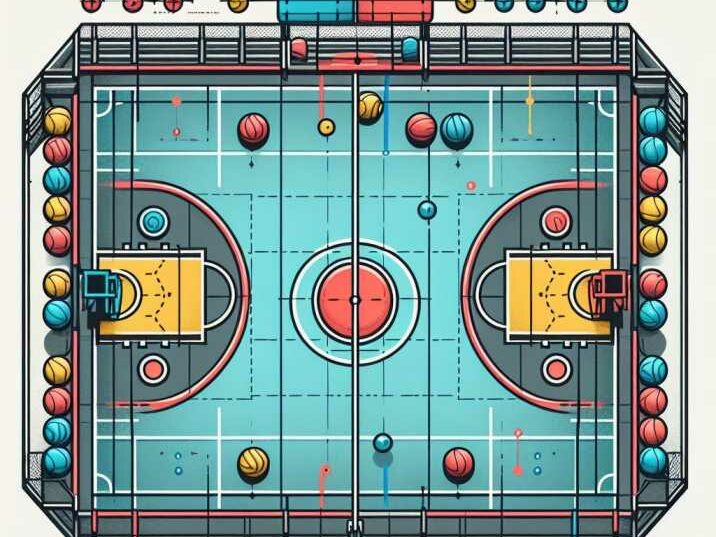Introduction:
Table of Contents
Dodgeball is a thrilling and fast-paced sport that has captured the hearts of players worldwide. Whether you’re dodging, ducking, diving, or throwing, dodgeball offers an exhilarating experience that combines strategy, agility, and teamwork. In this comprehensive guide, we’ll delve into the basic rules of dodgeball, providing you with the knowledge and skills you need to succeed on the court.

1. Understanding the Objective of Dodgeball
Dodgeball, a game played with two opposing teams, aims to eliminate players from the opposing team by hitting them with thrown balls while avoiding being hit oneself. The ultimate objective is to eliminate all players from the opposing team or have more players remaining when time runs out.
2. The Essential Equipment for Dodgeball
To play dodgeball, you’ll need specific equipment, including dodgeballs and a marked court. Dodgeballs are typically rubber balls of varying sizes and colors, while the court is divided into two sides, each designated for one of the competing teams.
3. Basic Rules of Dodgeball
a. Starting the Game: The game begins with both teams lining up on their respective sides of the court.
b. The Opening Rush: At the start of the game, both teams rush to the centerline to retrieve dodgeballs.
c. Throwing and Dodging: Players must throw dodgeballs at opponents while simultaneously dodging incoming throws.
d. Elimination: A player is eliminated if they are hit by a thrown ball or if they throw a ball that is caught by an opponent.
e. Catching: Players can catch thrown balls to eliminate the thrower’s team member and bring one of their eliminated teammates back into the game.
4. Understanding the Boundaries and Restrictions
a. Boundary Lines: Players must stay within the boundaries of the court during gameplay.
b. Headshots and Other Restrictions: In many variations of dodgeball, headshots are not allowed, and players must refrain from crossing the centerline or stepping out of bounds.
5. Strategies and Tips for Success
a. Communication: Effective communication among teammates is crucial for coordinating throws, positioning, and defensive maneuvers.
b. Target Selection: Strategically choose your targets based on their position, agility, and throwing ability.
c. Defense: Utilize defensive strategies such as blocking, dodging, and teamwork to avoid being hit by opposing throws.
6. Fouls and Penalties
a. Foul Play: Instances of foul play, such as intentional headshots or stepping out of bounds, may result in penalties or player disqualification.
b. Sportsmanship: Emphasize the importance of good sportsmanship, fair play, and respect for opponents and teammates.
7. Practice Drills and Training Exercises
To improve your dodgeball skills, consider incorporating practice drills and training exercises into your routine. These may include target practice, agility drills, and simulated gameplay scenarios.

Here’s a table summarizing key information about the basic rules of dodgeball:
| Topic | Description |
|---|---|
| Objective | Eliminate players from the opposing team by hitting them with thrown balls while avoiding being hit oneself. |
| Equipment | Dodgeballs (rubber balls of varying sizes and colors) and a marked court divided into two sides for competing teams. |
| Starting the Game | Both teams line up on their respective sides, and the game begins with an opening rush to retrieve dodgeballs. |
| Throwing and Dodging | Players throw dodgeballs at opponents while dodging incoming throws. |
| Elimination | A player is eliminated if hit by a thrown ball or if their thrown ball is caught by an opponent. |
| Catching | Players can catch thrown balls to eliminate the thrower’s team member and bring one of their eliminated teammates back into the game. |
| Boundaries & Restrictions | Players must stay within the court boundaries, and certain restrictions such as headshots may apply. |
| Strategies & Tips | Effective communication, strategic target selection, and defensive maneuvers are essential for success. |
| Fouls and Penalties | Foul play, such as intentional headshots or stepping out of bounds, may result in penalties or disqualification. |
| Practice Drills | Incorporate target practice, agility drills, and simulated gameplay scenarios into your training routine. |
This table provides a concise overview of the basic key aspects of and basic rules of dodgeball gameplay, helping players understand the fundamental elements of the sport.
Conclusion:
Mastering the basic rules of dodgeball is the first step toward becoming a skilled player. By understanding the objectives, equipment, gameplay rules, and strategies outlined in this guide, you’ll be well-equipped to navigate the dodgeball court with confidence and precision. So gather your team, grab some dodgeballs, and get ready to dodge, duck, dip, dive, and dodge your way to victory!
8. FAQs (Frequently Asked Questions)
- Can I block a thrown ball with another ball?
- Yes, you can use a dodgeball to block an incoming throw, but be cautious not to drop the ball or be hit by another throw simultaneously.
- How many players are typically on a dodgeball team?
- The number of players on each team can vary depending on the specific rules and regulations of the game. However, standard dodgeball teams often consist of six to ten players.
- What happens if a player catches a ball while already holding one?
- If a player catches a ball while already holding one, the player can only bring one eliminated teammate back into the game. The other caught ball is considered null.
- Are there different variations of dodgeball?
- Yes, there are various variations of dodgeball, including traditional dodgeball, foam dodgeball, and trampoline dodgeball, each with its own unique rules and gameplay dynamics.
- Is dodgeball a safe sport to play?
- While dodgeball can be physically demanding and competitive, adherence to proper safety guidelines and rules can help minimize the risk of injury and ensure a safe playing environment.


